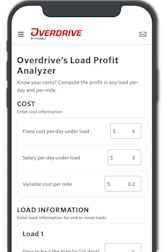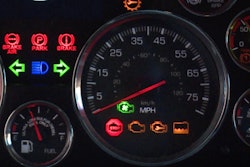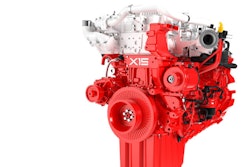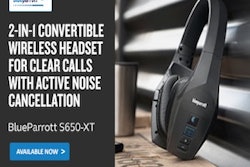The news from the Environmental Protection Agency concerning aftertreatment system faults in heavy-duty diesel trucks Tuesday this week, as previously reported, urged software updates to processes for engine derating in all heavy-duty trucks outfitted with selective catalytic reduction (SCR) systems. Prior sudden limitation of engines to 5 mph after as few as four hours of operation with certain faults in place, EPA hoped, would eventually be a thing of the past.
While the relaxed derating schedule in the new guidance roughly comports with what will be governing regulation for engines beginning in 2027, the formal guidance text makes clear that changes to derate procedures in existing engines are voluntary, though expressly recommended by current Trump administration regulators. And they apply "to any of a long list of potential 'fault codes' related to the DEF system, which on today’s trucks result in a 5-mph derate," EPA said. The agency added that the new guidance does not impact the manufacturer's ability to derate an engine to protect it from damage.
Engine power, for instance, might still be reduced if the engine begins to overheat. EPA’s guidance does not require or prohibit such consumer-protection-focused software.

And existing derate procedures related to SCR faults remain A-OK through at least the 2026 model year -- if the OEMs and their customers want them to be, that is.
In regulatory text, derates are called inducements, aimed as they are at convincing or inducing truck owners to fix aftertreatment problems by limiting the vehicle's operational performance over time.
The Owner-Operator Independent Drivers Association (OOIDA) welcomed the news from EPA, noting the guidance "establishes more commonsense inducement schedules that will help drivers maintain safe control of their vehicles as they diagnose and remedy faulty DEF/SCR systems," said OOIDA President Todd Spencer. "More flexible inducement speeds and times will help truckers finish their trips, plan for necessary maintenance, and avoid parking their truck for an extended period simply because of a false alarm. Nonsensical inducement rules have sidelined small-business truckers for too long and this accelerated relief shows what can be achieved when regulators hear directly from the people doing the job."
[Related: EPA announces end to 5-mph derates for new and existing trucks]
What truck makers are saying
Some engine makers, including Paccar, offered no comment about how any changes to existing equipment might be achieved after the Tuesday announcement. Daimler Trucks North America initially noted the company was well aware of the derate guidance but was "not in a position to comment further."
Later, though, DTNA updated the comment to note the company is "supportive of the efforts to provide more flexibility with regard to DEF inducement and are actively working on solutions to support our customers."
A Cummins spokesperson's statement also showed willingness to work with customers and regulators on modifying existing equipment.
"Selective Catalytic Reduction (SCR) is a widely accepted, proven technology utilized in many applications," said Cummins External Communications Director Melinda Koski, "and we are committed to working closely with the EPA and the select customers affected by SCR inducements. Together, we aim to provide regulatory certainty, greater flexibility, and the dependable solutions that contribute to the American economy.”
A Volvo Group spokesperson came closest to what's likely the point of view of any owner-operator who's been unlucky enough to experience a sudden derate. Volvo Group said they felt the EPA's "new strategy strikes the right balance between ensuring that potential system problems are addressed in a timely fashion and addressing customer concerns about the productivity impacts of the current inducements."
What EPA is proposing for programming existing vehicles differs from past sudden 5-mph derate procedures substantially, with initial torque reductions of just 15% after 650 miles or 10 hours of operation with a fault, then 30% at 4,200 miles, or 80 hours. The final step would be a derate to 25 mph at 8,400 miles, or 160 hours.
Volvo Group elaborated a bit by noting implementation of that in their engines "will be a software-only fix, which can be done over the air for model year 2020 and later vehicle models."
[Related: Practicing the fine art of exorcising 'aftertreatment demons' from your engine]
It would seem to offer better timing to owners to get vehicles to a service location to have whatever fault is in play addressed (and as any owner-operator knows, there are a myriad possibilities). One fleet maintenance pro consulted by Overdrive sister publication CCJ's Jason Cannon felt the recommended 8,000 miles an operator might achieve before any loss of speed with a system fault effectively kills the primary motivation -- that inducement, that is -- to get the aftertreatment problem repaired and repaired fast.
“Whatever is wrong isn't going to get better,” said Bison Transport USA director of maintenance Todd Cotier.
[Related: How to interpret your engine's warning-lamp language and ward off big problems]
Proactive maintenance still key to preventing more severe problems when aftertreatment faults arise
The most expensive result of powering through tiered derates? Potentially damaging a diesel particulate filter to the point it needs full replacement, Cotier added.
“When you’re backing up heat, you never know what kind of damage you can do,” retired Midwest Transport director of maintenance, John Sullivan, said.
Darry Stuart, founder of maintenance consulting firm DWS Fleet Management Services, noted at the point of a full derate, "you're probably, at that particular point, too far gone anyway. I don't think it's going to bring any additional expense by removing" the 5 mph derate, he said.
The good news? "I think, in the end, it probably will prevent a tow job," he said. That's a potential boon for convenience, and bedrock safety, if not maintenance expense. Stuart's worked more than one legal case "where trucks have been on the side of the road and cars come down and just whack 'em."
A truck suddenly limited to 5 mph has more odds of getting stuck in that sort of situation, and "while it's sitting there it's a potential accident," Stuart said.
Remember the old tried-and-true advice of maintenance pros going way back to the time before SCR systems came into play with the 2010 engines, even, when it was principally DPFs and passive and active regen processes owner-ops had to worry about when it came to emissions problems: Don't drive through the lights. That is, those warning lamps in the instrument cluster.
[Related: Used-truck pricing, long-term value: Emissions-system PM could play increasing role]
The potential problems that can result if you do are many.
Also consulted by Jason Cannon, Maverick Transportation Vice President of Maintenance Mike Jeffress underscored that "powering through" the derate tiers could potentially diminish the life of the catalyst long-term.
For owners and operators of newer trucks, monitoring the fault codes has certainly gotten simpler in recent years. Coupled with OEM or aftermarket telematics to broadcast faults to the owner (whether he/she's in the cab or the back office), Jeffress said, "if you're monitoring your fault codes, you're going to know you've got a problem. ... Right now, we get the broadcast if a unit is going to go into a derate and my team automatically calls the driver."
As past Overdrive Small Fleet Champ John McGee, with a Mack fleet hauling production water around the Louisiana oil fields, put it a couple years ago, a “broke truck ain’t making nobody no money."
It pays to correct the issue before too many miles go by and create bigger problems. --Jason Cannon, Alex Lockie, Matt Cole contributed reporting










